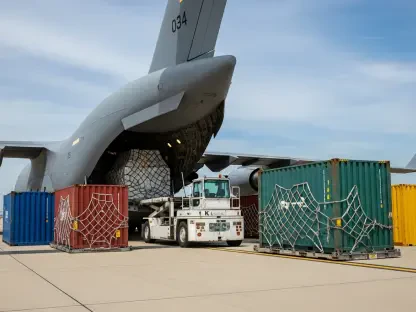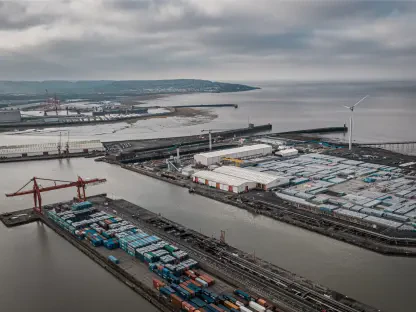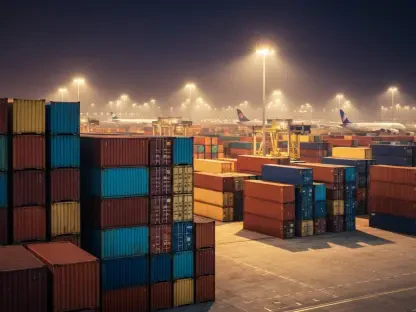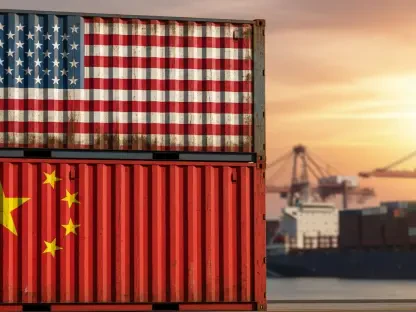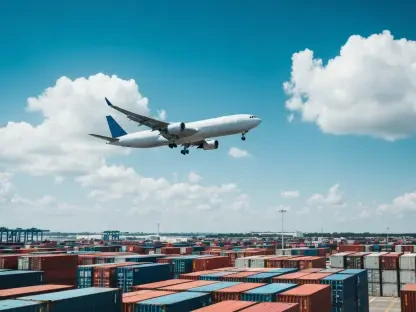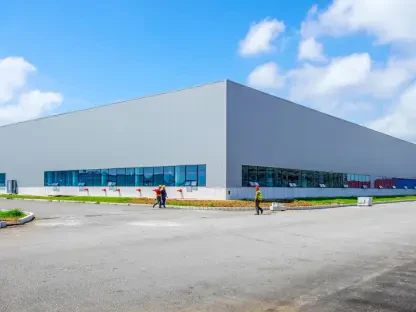Setting the Stage for E-Commerce Evolution
In the dynamic realm of e-commerce, Amazon stands as a titan, processing billions of transactions annually and commanding a significant share of global online retail. As of this year, the company’s logistics network handles an estimated 40% of U.S. e-commerce volume, a staggering figure that underscores its influence and dominance in the market. This market analysis delves into Amazon’s latest expansions in Multi-Channel Fulfillment (MCF) and supply chain technology, exploring how these innovations reshape seller capabilities and customer expectations. The purpose is to dissect current trends, evaluate data-driven impacts, and forecast future trajectories in a sector where speed and efficiency are paramount. By examining these strategic moves, this analysis aims to equip stakeholders with insights into navigating the increasingly complex landscape of global trade.
Deep Dive into Market Trends and Projections
Expanding Horizons with Multi-Channel Fulfillment
Amazon’s push to broaden MCF coverage marks a pivotal shift in e-commerce logistics, integrating major platforms like Walmart, Shopify, and Shein alongside existing partnerships with Etsy, Temu, and TikTok Shop. This expansion enables sellers to maintain a single inventory pool across diverse channels, a strategy that data indicates reduces out-of-stock scenarios by 19% and boosts inventory turnover by 12% when paired with Fulfillment by Amazon (FBA). Such metrics highlight a growing trend toward centralized inventory management, addressing seller pain points like fragmented stock and inconsistent delivery timelines. The market implication is clear: streamlined operations enhance competitiveness, particularly for small-to-medium enterprises vying for visibility across multiple marketplaces.
This trend also reflects a broader industry movement toward platform-agnostic fulfillment solutions. As e-commerce sales channels proliferate, sellers face mounting pressure to meet varied customer expectations without inflating operational costs. Amazon’s MCF expansion positions it as a linchpin in this ecosystem, potentially capturing a larger share of third-party logistics demand. Projections suggest that by 2027, over 60% of online merchants could rely on unified fulfillment services, driven by the need for efficiency in a market expected to grow at a compound annual rate of 10% over the next few years.
However, challenges persist in ensuring seamless integration across platforms with differing policies and delivery standards. Sellers must balance the benefits of centralized systems against potential complexities in syncing data and managing returns. Market analysis indicates that while Amazon’s infrastructure offers a robust foundation, competitors may soon replicate similar multi-channel offerings, intensifying the race for innovation and cost-effectiveness in fulfillment services.
Global Warehousing as a Cost-Saving Powerhouse
Another transformative development is Amazon’s Global Warehousing and Distribution service, which strategically places bulk storage near manufacturing hubs such as China and Vietnam, with expansion plans targeting Europe, Indonesia, and India. Pilot data reveals that this approach accelerates product movement into fulfillment networks by seven days, enabling same- or next-day delivery in key markets. This trend toward proximity-based warehousing addresses longstanding issues of lead time and shipping costs, critical factors as global e-commerce sales are projected to surpass $7 trillion by 2027.
The economic impact of this service lies in its ability to minimize inventory holding costs while enhancing supply chain flexibility. By storing goods closer to production centers, sellers can respond swiftly to demand fluctuations without overstocking in distant markets. Yet, geopolitical risks and regional demand unpredictability pose potential hurdles, as sudden disruptions could offset anticipated savings. Market forecasts indicate that such localized warehousing strategies could become standard within five years, with Amazon likely to maintain a first-mover advantage due to its expansive network and capital resources.
Furthermore, this initiative aligns with a growing emphasis on sustainability in logistics, as shorter shipping distances may reduce carbon footprints. Industry analysis suggests that as regulatory pressures for greener operations mount, companies adopting near-source warehousing could gain favor with eco-conscious consumers. Amazon’s early adoption of this model positions it to lead in both efficiency and environmental responsibility, potentially influencing market standards for logistics providers worldwide.
AI Innovations Reshaping Customs and Compliance
Amazon’s integration of generative artificial intelligence (GenAI) for customs clearance represents a cutting-edge trend in supply chain optimization. Early trials demonstrate a reduction in paperwork processing time by over 50%, achieved through automated form completion and error detection. This technological leap tackles a critical bottleneck in global trade, where delays at borders often cost businesses millions annually. The market significance is profound, as streamlined compliance processes could redefine how quickly goods move across international lines.
Adoption of AI in logistics is gaining traction industry-wide, with projections estimating that by 2027, nearly 70% of major e-commerce players will implement similar tools for administrative efficiency. Amazon’s approach, which emphasizes a hybrid model of automation with human oversight, mitigates risks of errors that could lead to penalties or shipment delays. This balance is crucial in regions with stringent regulations, such as the European Union, where compliance remains a top concern for sellers. The trend points to a future where technology and human expertise coexist to enhance operational precision.
Despite its promise, the market must address potential over-reliance on AI, as unverified outputs could result in costly mistakes. Analysis suggests that training and robust review mechanisms will be essential for widespread adoption. As competitors race to develop comparable solutions, Amazon’s early investment in GenAI could solidify its dominance in logistics tech, setting a benchmark for efficiency that others must match to remain competitive in a data-driven e-commerce landscape.
Logistics Speed through Direct Shipping Routes
Amazon Global Logistics (AGL) continues to redefine international shipping with direct ocean and air routes from manufacturing hubs like China to major markets including the U.S. and UK. With a goal to cover 96% of inbound volume to FBA within the next few years, AGL reduces handoffs and enhances delivery predictability. This trend toward direct logistics channels addresses a critical market need for speed, as consumer demand for rapid shipping continues to escalate, with over 50% of online shoppers expecting delivery within three days.
The strategic importance of AGL lies in its ability to bypass traditional multi-step shipping processes, cutting both time and cost. Market data indicates that faster inventory positioning correlates with higher customer satisfaction and repeat purchases, a key driver of revenue in e-commerce. Projections suggest that direct shipping models could become a standard for global logistics providers by the end of this decade, with Amazon’s extensive infrastructure giving it a significant edge over smaller competitors.
Economic factors, such as fluctuating fuel prices, and regulatory changes, like stricter emissions standards, will likely shape the evolution of this trend. Analysis points to a future where logistics providers must balance speed with sustainability, potentially integrating hybrid or electric transport options. Amazon’s proactive expansion of AGL signals its readiness to adapt to these shifts, positioning it as a leader in redefining global supply chain dynamics for e-commerce stakeholders.
Reflecting on Market Impacts and Strategic Pathways
Looking back, Amazon’s strategic expansions in Multi-Channel Fulfillment, global warehousing, AI-driven customs clearance, and direct shipping routes through AGL have reshaped the e-commerce logistics landscape. These initiatives have not only addressed immediate seller challenges like inventory inefficiencies and border delays but also set new benchmarks for speed and reliability in a fiercely competitive market. The data-driven improvements, from reduced out-of-stock incidents to faster delivery timelines, have underscored the transformative power of integrated supply chain solutions.
For businesses, the next steps involve leveraging these tools to optimize operations, starting with small-scale adoption of MCF across new platforms to test integration feasibility. Partnering with Amazon’s logistics for high-demand regions has proven effective in cutting costs, while investing in training for AI tools ensures compliance without errors. Monitoring key metrics like delivery speed and inventory turnover has been critical for refining strategies and maintaining customer satisfaction.
Moving forward, stakeholders need to anticipate further industry shifts, such as the rise of sustainable logistics practices and intensified competition in multi-channel fulfillment. Exploring hybrid models that combine technology with human oversight offers a pathway to balance innovation with reliability. Ultimately, adaptability has emerged as the cornerstone of success, guiding sellers and logistics providers alike to stay agile in an ever-evolving global marketplace.



